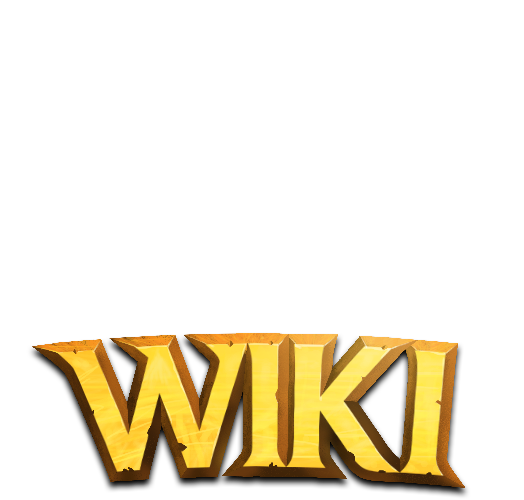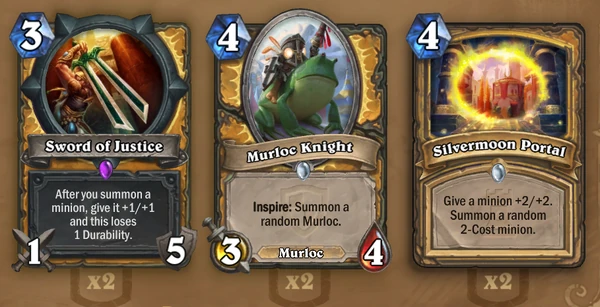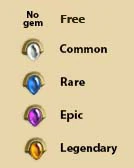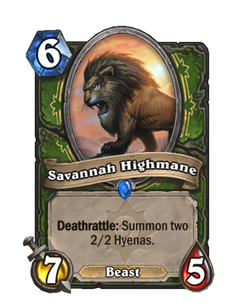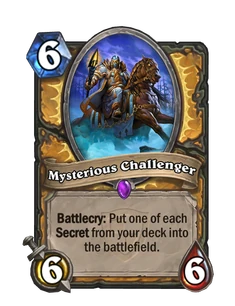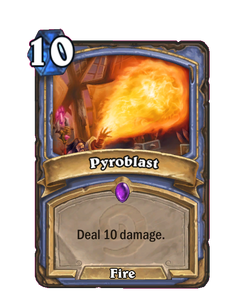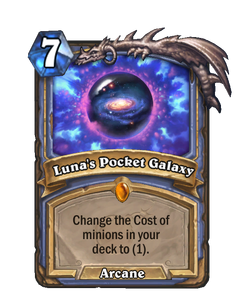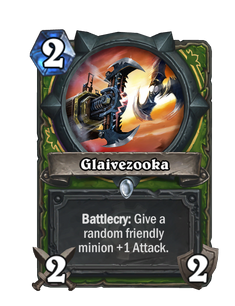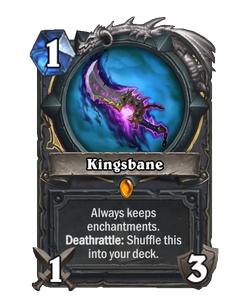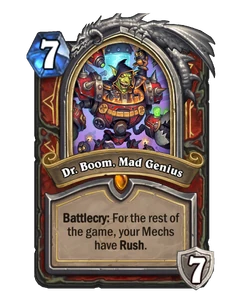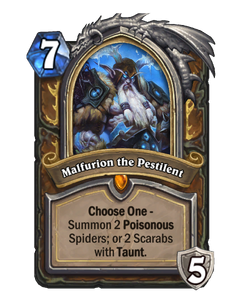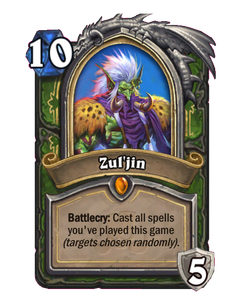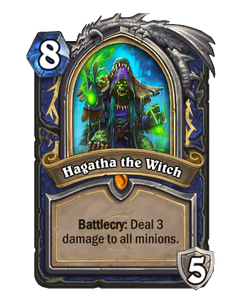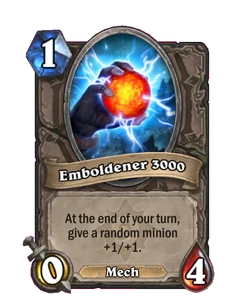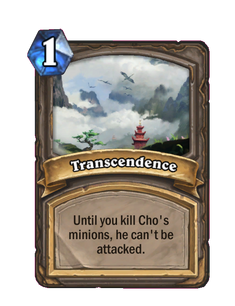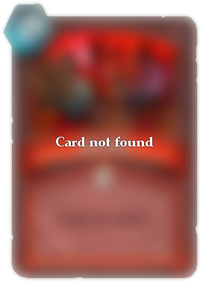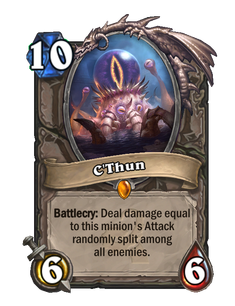Cards are the basic pieces that make up the game of Hearthstone. Each card represents an action that the player can take by playing that card. There are four main types of cards: minion cards, spell cards, weapon cards, and hero cards.
Cards are either collectible or uncollectible. Collectible cards come from a variety of card sets, including expansions, adventures, the two core sets of Basic and Classic, and the Hall of Fame set. Uncollectible cards can come from card sets as well, but most come from game modes such as Solo Adventures and Tavern Brawls. Only collectible cards can normally be used by players to create decks to play in the Casual and Ranked regular play modes.
As of Ashes of Outland, Hearthstone features more than 0 fully playable cards, of which exactly 2,496 cards can be collected by players. For the precise number of collectible cards found in each card set, see Card set table.
Card types and features
- For how the game is played, see Gameplay#Rules
There are four main types of cards in Hearthstone: minions, spells, weapons, and hero cards.
Mana is the main resource needed to be spent to play cards. All cards feature a mana cost in the top-left corner, typically ranging from 0 to 10 mana. (Some cards cost more than 10 mana, such as Molten Giant or
Mountain Giant.) Each card features a portrait, a title, and a main panel with card text. For minion and weapon cards, the main panel describes special effects or abilities that the card possesses. For spell cards, the main panel describes the effect of playing that card.
- Minion cards have an Attack value in the bottom-left corner, and a Health value in the bottom-right corner.
- Examples:
Archmage Antonidas,
Sludge Belcher,
Weasel Tunneler
- Examples:
- Weapon cards have an Attack value in the bottom-left corner, and a Durability value in the bottom-right corner.
- Examples:
Silver Sword,
Shadowblade,
Fiery War Axe
- Examples:
- Spell cards have only a mana cost attribute. The ability of the card is described by the card text.
- Examples:
Flamestrike,
Devolve,
Defile
- Examples:
- Hero cards have a mana cost attribute and an Armor value in the bottom-right corner. Hero cards replace a player's hero and Hero Power when played, and they have abilities described in the card text.
- Examples:
Deathstalker Rexxar,
Frost Lich Jaina,
Shadowreaper Anduin
- Examples:
Card text described in the main text panel of a card is arguably the most important feature of a card. Card text can appear on any card and can describe any number of abilities. Some abilities appear frequently on cards, and these are bold-faced as keyword abilities. Some keyword abilities worth mentioning are Battlecries, Taunts, and Deathrattles. The descriptions of these abilities can be found on their respective pages. Most but not all abilities can be removed by using Silence effects, such as with Ironbeak Owl.
Categories
Cards are mainly categorized by card set, class, and rarity.
Card set
- Main article: Card set
Cards are divided into many card sets in Hearthstone. A complete list of card sets includes: Basic, Classic, expansion sets, adventure sets, and the Hall of Fame set. Card sets reflect how a card can be obtained, and they determine whether a card can be valid to be played in Standard format, a game format for both new and current players.
Most Basic cards are automatically included in a player's collection, while half of all class-specific Basic cards are obtained through leveling a hero of that class to level 10. Classic cards, and cards from expansion sets, such as Mean Streets of Gadgetzan, are obtained from opening their corresponding card packs, as well as through crafting. Cards from adventure sets, such as League of Explorers, are acquired through defeating certain bosses in their corresponding adventure.
For more information on card sets and a list of all card sets, see the main article: Card sets.
Class
- Main article: Class
Cards are categorized into classes and can be either class-specific or Neutral. Class-specific cards are categorized into ten main classes, with access to these cards restricted only to heroes of that class. Cards in each class have their own unique playstyles; for example, Mage is known for playing with spells, Priest is known for playing with healing, etc. In addition to cards in the ten main classes, cards can also be of a Neutral class. Neutral cards are available to be included in the decks of heroes of any class. Summarily, collectible cards are divided into a total of ten main classes alongside an omnipresent Neutral class:
Rarity
- Main article: Rarity
Rarity determines the difficulty at which it is to acquire a card, with higher rarities typically being more powerful but harder to obtain from packs and more expensive to craft. Five rarities exist in total:
Collectible cards
- Main article: Collectible
Cards are either collectible or uncollectible. Collectible cards can be added to a player's collection, while uncollectible cards cannot. Both collectible and uncollectible cards comprise the playable cards that can be used in games.
Collectible cards are viewed and inspected through the My Collection screen. New players start the game with a collection of basic cards which includes a large range of neutral minion cards and 5 basic cards specific to each class.
Collecting cards
- Main article: Collection manager
Players can receive new cards in a number of ways:
- by leveling heroes
- from card packs, which may be bought with real money or with gold, or rewarded from Arena wins or certain unique quests
- by crafting a new card from Arcane Dust
- by defeating bosses and completing wings in adventures
- a few specific cards can be obtained as rewards for completing unique quests, or as part of promotions
Players can include up to 2 of any individual card in a single deck, with the exception of legendary cards, which can only be included once in each deck. Extra cards can be disenchanted for Arcane Dust, a resource used in the creation of cards, with rarer cards being able to be disenchanted for more dust. Players are not able to trade cards with other players.
Whizbang the Wonderful and
Zayle, Shadow Cloak are exceptions most rules applied to collectible cards. They never start in a deck in play mode, and cannot be part of 30-card decks. They can, however, complete a deck by themselves. When added to a deck, they will remove all other cards in the deck. These one-card decks will have custom hero portraits in the collection manager unique to them, and they transform into random premade decks when entering play mode. For further information, see Whizbang the Wonderful#Notes and Zayle, Shadow Cloak#Notes
Golden cards
- Main article: Golden card
All collectible cards are available to be obtained in a golden version, a purely aesthetic enhancement. These are extremely hard to obtain, requiring a lot of pack openings, or a lot of dust to craft.
Minion cards
- Main article: Minion
Minions are permanent creatures on the battlefield that will fight for their hero. Minion cards can be recognized by their Attack (a number displayed on a yellow sword, in the bottom left corner) and Health (a number displayed on a red blood drop, in the bottom right corner). Minions are controlled by the player who summoned them, and can be commanded to attack their opponent's minions, or the opposing hero, while minions with Taunt can act as tanks, preventing the opponent's forces from attacking the hero directly with melee attacks until that minion is destroyed. Minions are a major element in battles between heroes, and are usually responsible for the majority of all damage dealt in a game. Minions are the most common type of card.
For a full list of minion cards, see Minion.
Spell cards
- Main article: Spell
Spell cards are cards that can be played to trigger a one time effect or ability, described in the card's text. In contrast to a minion or weapon card, a spell card will expire immediately after it has been used. Spell cards do not have Attack or Health attributes, and are the second most common type of card.
For a full list of spell cards, see Spell.
Weapon cards
- Main article: Weapon
Weapons are special cards which can be equipped by heroes. Each weapon has an Attack value and a Durability value. Each hero can only equip one weapon at a time, and equipping a new weapon will destroy the old one. Attacking using a weapon deals damage equal to its Attack, and reduces its Durability by 1. When a weapon's Durability is reduced to zero, the weapon will be destroyed. All classes have weapons available to them, with rogues, paladins and warriors generally considered to have the greatest synergy with weapons.
For a full list of weapon cards, see Weapon.
Hero cards
- Main article: Hero card
Hero cards are cards which, upon being played, replace the controlling player's hero, giving them a small amount of Armor (the number of which is displayed on a gray shield icon, in the bottom right corner) and replacing their Hero Power with a new, unique one, but retaining the player's current and maximum Health. Hero cards were first introduced in the Knights of the Frozen Throne expansion, and marks the first time an entirely new card category has been added to the game since launch. Hero cards are the least common type of card. All collectible hero cards are of legendary rarity.
For a full list of hero cards, see Hero card.
Uncollectible cards
- Main article: Uncollectible
Uncollectible cards are cards which cannot be added to a player's collection; in other words, players cannot permanently acquire these cards. Most uncollectible cards are generated from collectible cards during regular play; however, some uncollectible cards are not seen during actual play, such as debug cards and credits cards.
Boss cards
- Main article: Boss card
Boss cards are cards used by bosses in adventures such as Curse of Naxxramas and during the game's tutorial. They are not available in normal play.
Tavern Brawl cards
- Main article: Tavern Brawl card
Tavern Brawl cards are special cards only available to players when participating in a specific Tavern Brawl. They are not available outside of their specific Tavern Brawl events.
Removed cards
- Main article: Removed card
Removed cards are valid Hearthstone cards which have been removed from play. These cards can no longer be collected or found in-game. All of the current list of removed cards were removed during the game's alpha or closed beta test phases.
While the majority of the characters, abilities and weapons in Hearthstone come from World of Warcraft, or the Warcraft universe in general, some have made their debut with Hearthstone itself. Hearthstone has also introduced numerous new character types, and titles for existing types.
Unavailable cards are cards which although appearing in the game in some way are never available for players to use.
Credits cards
- Main article: Credits card
Credits cards are non-playable cards that depict members of the Hearthstone development team. These cards are not found in play, but are displayed during the game's credits, accessed through the options button from the game's main menu. There are 17 credits cards, depicting the 15 members of Team 5, and the game's two executive producers.
Debug cards
- Main article: Debug card
Debug cards are cards designed for testing and debugging Hearthstone. Designed for use in a specific testing environment, these cards often feature outlandish powers, and are not available to players.
System cards
- Main article: System card
System cards are non-available cards used by the game system and are very similar to debug cards. Currently one known system card exists, which is C'Thun.
Card backs
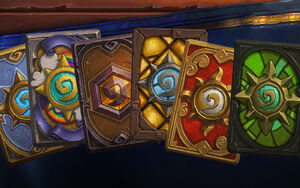
An example of alternate card backs that can or could have been collected
- Main article: Card back
Card backs are a Hearthstone feature which allows players to replace the standard design on the reverse of their cards with alternate designs. Players can earn alternate card backs through fulfilling various criteria, such as winning 5 games in Ranked mode in a season of Ranked play, or completing certain quests. Several different card backs are available to collect, with each offering a distinct animated design. Players can choose which available card back to use, with the selected design displayed in-game on the backs of the player's cards, visible to both the player and their opponent. Card backs are purely decorative and do not affect gameplay in any way.
Card art
- Main article: Card art
The art used on Hearthstone's cards is one of the most striking and memorable aspects of the game's artistic design. These small yet detailed images are usually taken from far larger pieces of art, with only a small section used in the game. The majority of card art for Hearthstone was previously used for the World of Warcraft Trading Card Game, but some pieces were specially commissioned for the game, such as that for ![]() Anduin Wrynn.
Anduin Wrynn.
Original cards in Hearthstone
- Main article: Original cards in Hearthstone
Hearthstone cards were originally primarily based on pre-existing characters introduced elsewhere in the Warcraft universe. However, over time Hearthstone — while still set in the Warcraft universe — has introduced many new characters and concepts exclusive to Hearthstone. At the end of 2016, a name change occurred for the game, changing "Hearthstone: Heroes of Warcraft" to simply "Hearthstone".
For an overview and history of new lore, see Hearthstone lore. For a list of Hearthstone cards inspired by the World of Warcraft Trading Card Game, see World of Warcraft Trading Card Game.
